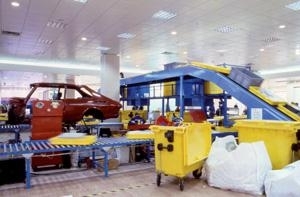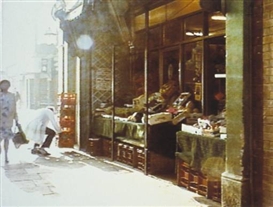Under Destruction II
Jean Tinguely‚Äôs ‚ÄúHomage to New York‚ÄĚ was performed in MoMA‚Äôs Sculpture Garden on an icy winter evening in March, 1960.
Jen Schwarting / The Brooklyn Rail
01 Jul, 2011

SWISS INSTITUTE | MAY 18‚ÄÜ‚Äď‚ÄÜJUNE 19, 2011
Jean Tinguely‚Äôs ‚ÄúHomage to New York‚ÄĚ was performed in MoMA‚Äôs Sculpture Garden on an icy winter evening in March, 1960. The sprawling, scaffold-like kinetic sculpture was built onsite, and both the inclement weather and outsized scope of production were likely factors in the failure of the mechanized structure to fully operate and self-destruct as planned. Still, Tinguely‚Äôs vast assemblage of inter-connected appliances was wildly ambitious, chaotic, and for the audience, uniquely visceral, as overlapping audios produced a vociferous roar and smashed-together bottles released a rancid stench‚ÄĒall before the machine caught on fire.
Under Destruction II opens to what sounds like a demolition site and a clamoring of potential energy. Competing for attention are the amplified soundtracks of three adjacent videos: the reverberate screeching in Christian Marclay‚Äôs ‚ÄúGuitar Drag‚ÄĚ (2000); the hum of reciprocating saws in Michael Landy‚Äôs ‚ÄúBreak Down‚ÄĚ (2001); and the perpetual whump of rocks striking metal in Jimmie Durham‚Äôs ‚ÄúStoning the Refrigerator‚ÄĚ (1996). The videos are intermittently drowned out by the sound of Liz Larner‚Äôs ‚ÄúCorner Basher‚ÄĚ (1988), a viewer-operated, kinetic sculpture topped by a wrecking ball that spins, lurches, and destroys the gallery walls with an unpredictable force.
The exhibition is thrilling, and many of the works in the vein of Tinguely serve up wit with destruction, such as Martin Kersels‚Äôs ‚ÄúPink Constellation‚ÄĚ (2001), a model bedroom built to rotate 360 degrees. In the video documentation, Kersels performs in the room as it is literally turned upside-down and he is comically, yet disconcertingly, crushed by falling furniture. Intensifying the viewer experience with biting humor and a pervasive, sickly-sweet smell is Johannes Vogl‚Äôs ‚ÄúUntitled (Machine To Produce Jam Breads)‚ÄĚ (2007), a mechanized assembly system dispensing piles of breakfasts that continually go to waste.
Themes of reckless consumption and exhaustion permeate the exhibition, though Michael Landy‚Äôs ‚ÄúBreak Down‚ÄĚ most closely mirrors Tinguley‚Äôs critical position on consumerism and accumulation. In 2001, Landy took all of his possessions to a London showroom, displayed them on a large circuit of moving conveyor belts in a factory-like setting, and organized uniformed workers to categorize, chop-up, shred, and destroy everything he owned. ‚ÄúEverything‚ÄĚ included his passport, his car, and valuable works made by his friends Gillian Wearing and Damien Hirst. The destruction of artworks was Landy‚Äôs ultimate statement of artistic commitment to his project‚ÄĒdeemed by the Turner Prize committee an act of unforgivable transgression‚ÄĒand controversial enough to allegedly cost the artist the prize.
‚ÄúBreak Down‚ÄĚ is a work of daring and determination, and‚ÄĒwith so much at stake for the artist‚ÄĒ deeply satisfying for a viewer to consider. Lately, a lot of work being shown in the New York galleries seems, by contrast, purposely provisional, flat, formal, and so polite. The aggression, intensity, and dark humor of the works in the exhibition, many completed about a decade ago, feels refreshing‚ÄĒand yet somehow, clearly dated. The works recall a preoccupation with entropy and demonstrate a time, just before the digital age as we know it, when clunky machines and industrial appliances, pick-up trucks, and refrigerators could still represent a power to be subverted.
If there is renewed interest in this approach, it can currently be seen at the US Pavilion in Venice, as Allora and Calzadilla‚Äôs massive overturned military tank spins its wheels. While their machine noisily portends a nation‚Äôs exhaustion of resources, society‚Äôs ultimate doom and destruction will probably appear in the form of something far more innocuous. We should keep an eye on Christian Marclay, who often has his finger on the pulse, winning the Biennial award with his utterly brilliant ‚ÄúThe Clock‚ÄĚ‚ÄĒa riveting, meticulously crafted loop of Hollywood entertainment that runs 24 hours, non-stop.

 ARTISTS
ARTISTS













